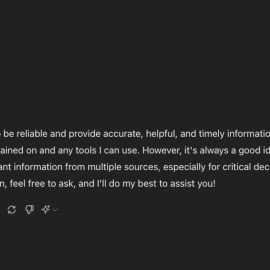

This article is an excerpt from the Shortform book guide to "Amplify Your Influence" by René Rodriguez. Shortform has the world's best summaries and analyses of books you should be reading.
Like this article? Sign up for a free trial here.
Are you nervous about a big presentation coming up? Would you like to give a presentation that people will remember?
René Rodriguez’s book Amplify Your Audience dives into a specific kind of communication that everyone should master: presenting in front of a group of people. Rodriguez provides tips for things you should do before and during your presentation that will boost its chances of success.
Keep reading to learn how to give a good presentation with Rodriguez’s guidance.
Tip #1: Study Recordings of Yourself Presenting
Rodriguez shares his advice on how to give a good presentation, asserting that preparing for presentations should be an ongoing process of improvement. He recommends taking a video of yourself any time you’re presenting and then reviewing it before your next presentation. Pay attention to the points you discussed and how you delivered them. Which parts seemed to work for the audience, and which didn’t?
Watching recordings also reveals unhelpful quirks in your body language that you may not otherwise realize you have. Your body language has a significant effect on how your ideas will be received by your audience, so it’s important to understand how you look when presenting. If your body language contradicts the main idea you’re attempting to communicate, your audience may lose interest and trust.
For example, if you’re a motivational speaker, and you shift back and forth on your feet whenever you present, your audience likely won’t look to you as a source of motivation or inspiration. Shifting your feet suggests discomfort and nervousness, not the confidence and groundedness better suited to the purpose of your presentation.
(Shortform note: Though many agree with Rodriguez that this technique can help you improve your public speaking skills, a lot of people struggle to watch recordings of themselves. This aversion may come from a lack of confidence or feelings of embarrassment. If you experience this struggle, you can make the process easier by pretending the speaker isn’t you: Think about how you would feel watching yourself as an audience member. By acting as if you’re an outside observer, you can more easily and objectively assess your performance.)
| How to Rehearse for More Natural Body Language If you watch a video of yourself presenting and notice a lot of quirks in your body language, you may think that rehearsing specific poses or actions will make you look more polished and professional. However, that kind of preparation typically makes body language look less natural to audiences—it’ll make you look stiff and contrived. Instead, rehearse your body language based on four more general key goals that represent qualities of a successful presentation: to show passion, to display openness, to connect, and to listen. Practice your presentation four different times, keeping a different goal in mind each round. Instead of thinking about the goal, try to feel it—if you focus on the feeling, your body language will naturally represent the goal authentically. |
Tip #2: Get Outside Feedback
Rodriguez also suggests getting external feedback on your presentations. Hearing other people’s honest responses and comments is an important part of growth—we often overestimate our own skills, so outside feedback can be a valuable reality check.
(Shortform note: In psychology, the tendency to overestimate our knowledge, skills, and abilities is called overconfidence bias. This bias can have small consequences (such as missing a project’s deadline because we assume it will take less time than it actually requires) or serious consequences (such as a doctor assuming their diagnoses are always correct). In addition to getting feedback from others, you can combat overconfidence bias around presenting by doing a “premortem” for presentations. This means thinking about things that could go wrong while you’re presenting and working backward to imagine how they might happen. That way, you can anticipate and avoid potential failure.)
Tip #3: Take Steps to Minimize Your Anxiety
According to Rodriguez, to be successful, you must proactively manage any anxiety and stress you have about your presentation. If you’re unable to do this, none of his other strategies will offer much benefit.
(Shortform note: Research suggests that Rodriguez’s emphasis on managing presentation stress is relevant to many people: Public speaking is the most common phobia, beating out other common fears such as the fear of death, the fear of heights, and the fear of spiders. The National Institute of Mental Health estimates that about 40% of the population experiences public speaking anxiety.)
Rodriguez explains that stress makes it impossible for you to execute cognitively demanding tasks—including presentations—at your best. When you’re stressed, your autonomic nervous system (the part of your nervous system responsible for automatic body processes like breathing, digestion, and your heartbeat) activates. Its job is to protect you from danger, so when it perceives something as a threat (like a presentation), it sends you into the fight-or-flight response.
To prepare your body to face or flee the perceived danger, this response shuts down higher-level thinking, making it difficult to present effectively. Therefore, you must use techniques that help you calm the stress response.
(Shortform note: Along with breathing techniques (which we’ll discuss below), you can use many different methods to calm your body’s stress response and refocus your mind. First, studies show that chewing gum can reduce stress and anxiety, increase focus, and improve short-term memory. Some researchers attribute these cognitive benefits to the increased blood flow to the brain that results from chewing. Second, laughing can make you feel calmer—it raises then lowers your blood pressure and heart rate, assuaging the stress response and leaving you feeling relaxed. Therefore, if you need to break out of fight-or-flight mode and calm your nervous system, try watching a funny video or talking to someone who makes you laugh.)
Strategy: Stress-Relieving Breathing Technique
Breathing techniques can be a great way to relieve stress. For example, Rodriguez suggests box breathing. To use this technique, breathe in for four counts and pause for four counts. Then, breathe out for four counts and pause again for four counts. Repeat this cycle of breath for as long as you need to feel more centered and calm.
(Shortform note: One aspect of box breathing that calms you down is the act of counting—your brain becomes occupied with keeping track of the counts, distracting you from your worries. Keeping the number of counts and steps to four means the pattern is easier to learn and remember, making it a useful tool when you’re already stressed and likely to forget a more complicated exercise. The technique gets its name from its four-count pattern and four-step cycle since a box has four sides.)
Tip #4: Maintain the Audience’s Attention Using Variety
Rodriguez states that once you have your audience’s attention, you need to maintain it throughout your presentation. If your presentation is unengaging, then your audience will lose interest, and they won’t hear your main idea. You can keep them engaged by employing various stimuli to introduce variation and creativity into your presentation.
(Shortform note: One way to engage your audience is to pay close attention to your voice: Simply Said author Jay Sullivan says to monitor the speed, volume, and tone of your speech. First, many people talk too quickly out of nervousness, so practice talking at a pace that’s easily understandable and allows time for the audience to process your words. Second, practice projecting your voice so the person who’s farthest away from you can hear you clearly (especially if you won’t be using a microphone). Third, avoid presenting in a monotone voice. To keep your audience’s attention, your voice should be dynamic and energetic—this arguably introduces the variation Rodriguez emphasizes.)
Variation is important to include in a presentation because of how our brains work. Our cerebral cortex—the part of our brain that’s responsible for learning and creativity—thrives off of stimulation from new ideas and innovation. When we’re first introduced to a new stimulus, it captures the attention of our cerebral cortex. However, if the stimulus stays the same, after a while, our brain will lose interest.
(Shortform note: In Talk Like TED, Gallo suggests using a “shocking moment” to introduce novelty into your presentation: an event your audience doesn’t expect that deeply surprises, impresses, or moves them. You can create a shocking moment by giving a demonstration, including startling statistics, or displaying a shocking photo or video. Gallo argues that they’re effective because their unexpectedness grabs the audience’s attention (as Rodriguez suggests), making the audience members more focused on and thus more likely to absorb your ideas. Additionally, they prompt people to tell others about your ideas because people want to talk about the exciting thing they witnessed.)
For example, if you create a PowerPoint presentation to present information using simple text on the same background for every slide, your audience is likely to quickly lose interest. If you create slides that incorporate visuals and break up the presentation with stories and videos, you’ll be able to maintain your audience’s attention much more easily.
(Shortform note: Chris Anderson, author of TED Talks, states that not all presentations require a visual aid (such as slides). For example, humor and emotion in stories can evoke enough interest in an audience that a visual element isn’t necessary to engage meaningfully with them. However, a visual presentation can be helpful if something is easier to show than describe, or if you’re discussing a visual topic, such as art. If you choose to make slides, use an easy-to-read font like Arial or Helvetica, use high-quality images and credit them subtly on the same slide, and keep videos under 30 seconds.)

———End of Preview———
Like what you just read? Read the rest of the world's best book summary and analysis of René Rodriguez's "Amplify Your Influence" at Shortform.
Here's what you'll find in our full Amplify Your Influence summary:
- How you can help others reach their goals and improve their behavior
- How to use Aristotle's four rhetoric appeals to connect with an audience
- Tips on what to do before, during, and after a presentation






